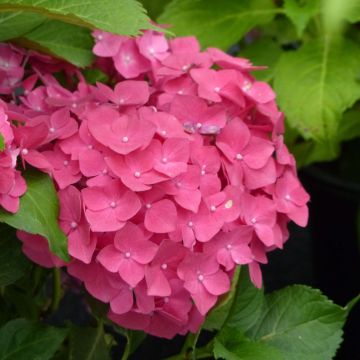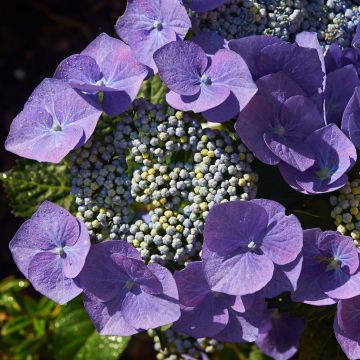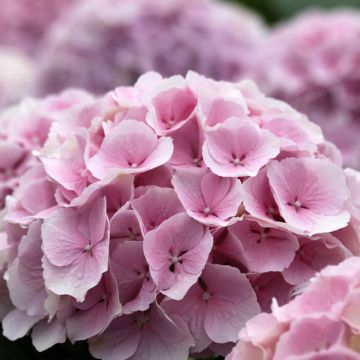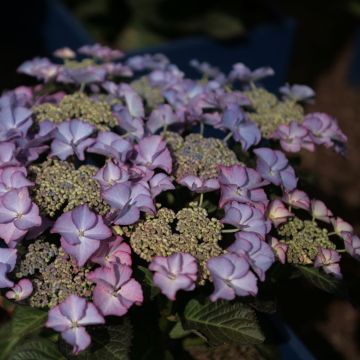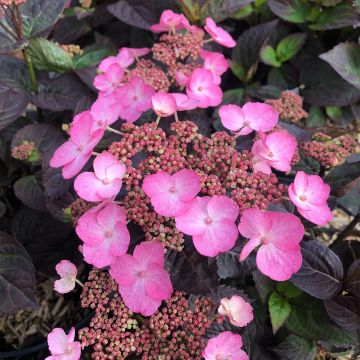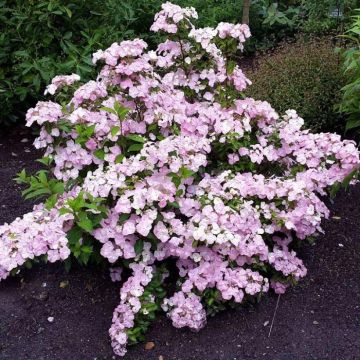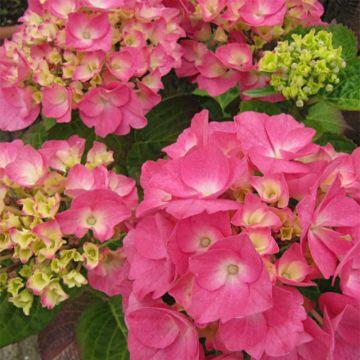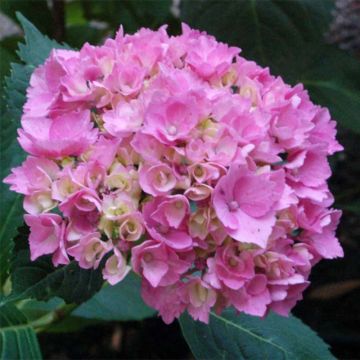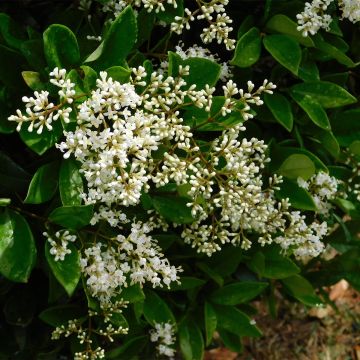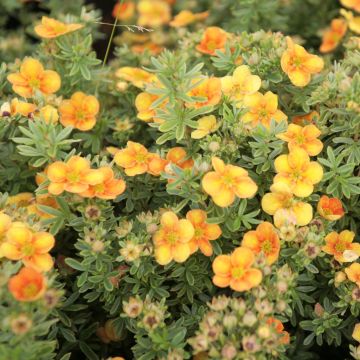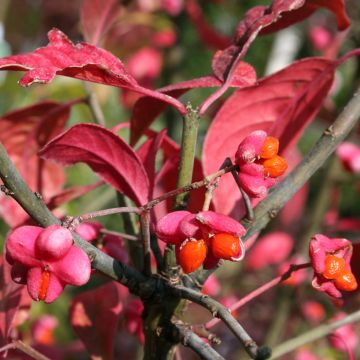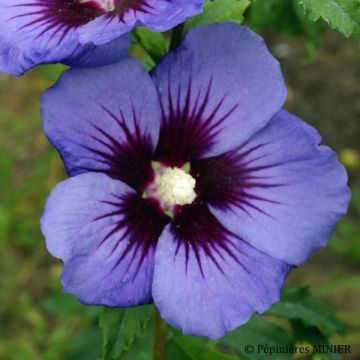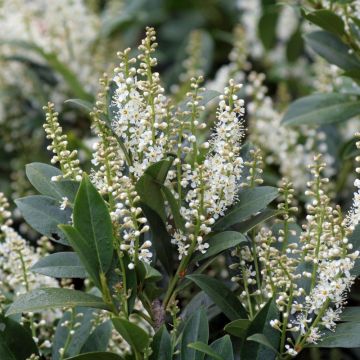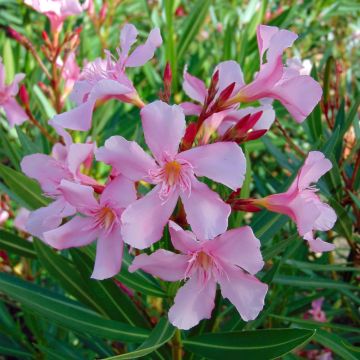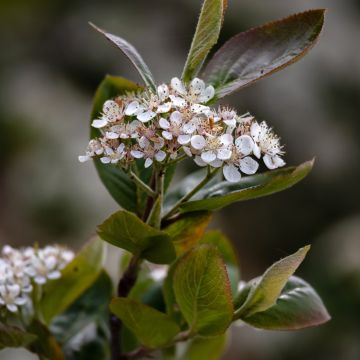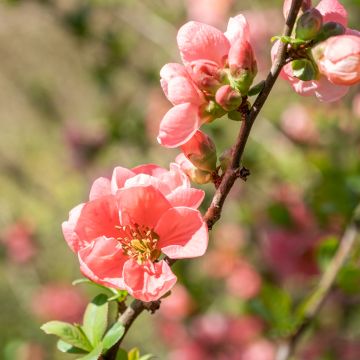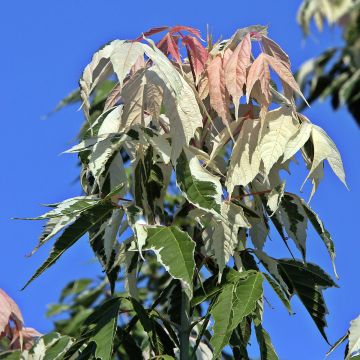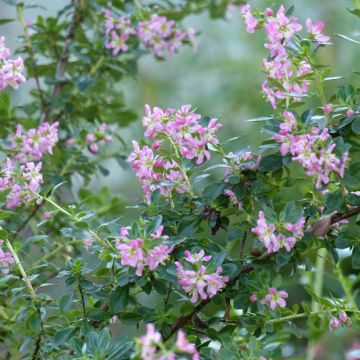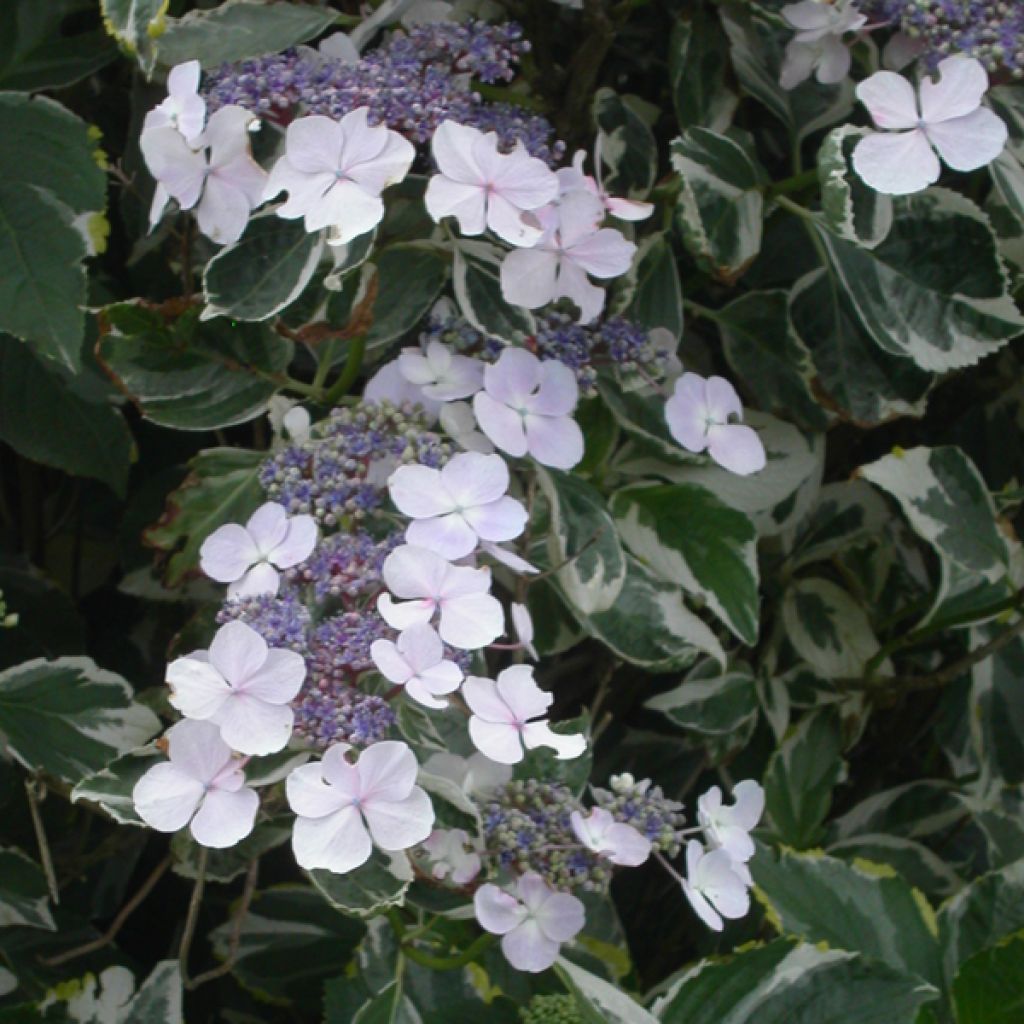

Hydrangea macrophylla Tricolor
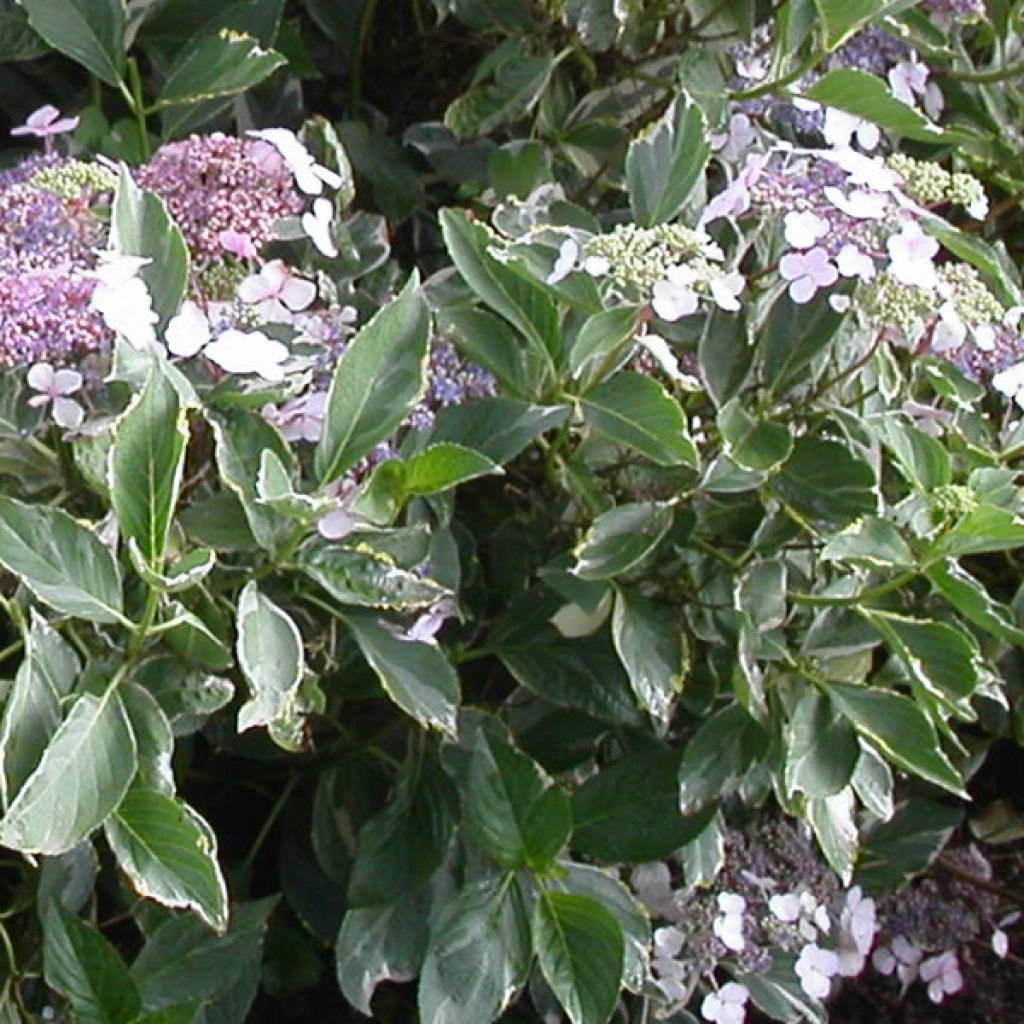

Hydrangea macrophylla Tricolor
Hydrangea macrophylla Tricolor
Hydrangea macrophylla Tricolor
Bigleaf Hydrangea, French Hydrangea
This item cannot be shipped to the selected country
Delivery charge from €5.90
More information
Schedule delivery date,
and select date in basket
This plant carries a 24 months recovery warranty
More information
We guarantee the quality of our plants for a full growing cycle, and will replace at our expense any plant that fails to recover under normal climatic and planting conditions.
From €5.90 for pickup delivery and €6.90 for home delivery
Express home delivery from €8.90.

Does this plant fit my garden?
Set up your Plantfit profile →
Description
Of extreme delicacy, Hydrangea macrophylla 'Tricolor' is a variety of Hydrangea with foliage variegated with bright green, cream, and yellow. At the end of July, its beautiful flat, irregular, and light inflorescences appear, first pale pink or very pale blue in acidic soil, turning pale mauve with age. It is a vigorous bush, comfortable in hedges and flower beds, to brighten up an understorey or a dark corner in the garden. It will thrive in partial shade or even in a sunny exposure. This variety blooms until autumn.
Hydrangea macrophylla 'Tricolor', initially named 'Variegata', is an old creation, obtained in 1843, which has a unique and endearing personality. It comes from H. macrophylla and H. aspera, among others. The Hydrangea family is native to China and Japan. 'Tricolor' is part of a series of "Lacecap" cultivars selected for their flat cymose inflorescences. This bush has a rather round and regular habit. It reaches a height of approximately 1.50m with a spread of 1.20m (4ft). From late July to October-November , its small fertile and sterile flowers, with striking dimorphism, form irregular and very natural-looking spherical inflorescences 18 to 22cm in diameter. They are composed of a sparsely arranged row of sterile florets, blue or pale pink depending on the soil acidity, surrounding a beautiful central bouquet of darker fertile florets. The flowering spreads over magnificent foliage, wavy, irregularly variegated with green, cream, and yellow. The variegation will be more pronounced in very poor soil. The leaves are opposite, reaching at least fifteen centimetres in length. They are simple, ovate to elliptical, ending in a tapered point, almost entire. Hydrangeas can live for at least 50 years.
The 'Tricolor' Hydrangea is a refined plant but with a very natural appearance. Hydrangeas are well known for brightening up the north side of houses. This one will even thrive in the sun, in a non-burning exposure, in flower beds as well as hedges. It can easily be associated with other flowering shrubs, such as deciduous azaleas, mountain laurels, small magnolias, or rhododendrons in acidic soil. Although Hydrangeas fear limestone, they are not strictly speaking ericaceous plants. Also, mix them with Magellan fuchsias, annual impatiens, or plant spring-flowering bulbs in front of their round silhouette. Enjoy their sumptuous flowering in the garden or in the house for a long time.
Report an error about the product description
Hydrangea macrophylla Tricolor in pictures
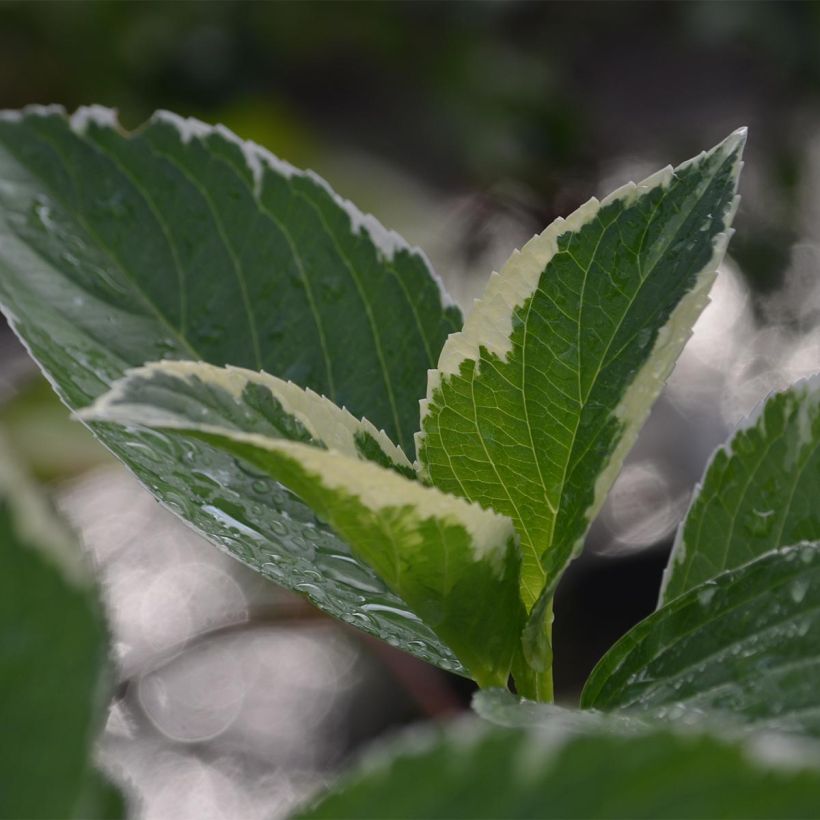

Plant habit
Flowering
Foliage
Botanical data
Hydrangea
macrophylla
Tricolor
Hydrangeaceae
Bigleaf Hydrangea, French Hydrangea
Cultivar or hybrid
Other Hydrangea Macrophylla
Planting and care
Plant Hydrangea macrophylla 'Tricolor' in spring or early autumn, preferably in a semi-shaded or non-burning sun position, for example against an east-facing wall or even north-facing. In very cold regions, it may be prudent to protect it with a winter cover, especially since the flowering can be damaged by late frosts. Near a wall, it will be sheltered from cold and drying winds. It does not necessarily require heather soil, but appreciates a deep, moist, well-drained, fairly fertile soil, possibly enriched with a good base fertilizer before planting. If the soil is dry at the base of the wall, plant the root ball at least 30-40cm (11.8 - 15.7in) away from the base of the wall and incorporate a quantity of well-decomposed compost to better retain moisture in the soil.
Planting period
Intended location
Care
-
, onOrder confirmed
Reply from on Promesse de fleurs
Hedge shrubs
Haven't found what you were looking for?
Hardiness is the lowest winter temperature a plant can endure without suffering serious damage or even dying. However, hardiness is affected by location (a sheltered area, such as a patio), protection (winter cover) and soil type (hardiness is improved by well-drained soil).

Photo Sharing Terms & Conditions
In order to encourage gardeners to interact and share their experiences, Promesse de fleurs offers various media enabling content to be uploaded onto its Site - in particular via the ‘Photo sharing’ module.
The User agrees to refrain from:
- Posting any content that is illegal, prejudicial, insulting, racist, inciteful to hatred, revisionist, contrary to public decency, that infringes on privacy or on the privacy rights of third parties, in particular the publicity rights of persons and goods, intellectual property rights, or the right to privacy.
- Submitting content on behalf of a third party;
- Impersonate the identity of a third party and/or publish any personal information about a third party;
In general, the User undertakes to refrain from any unethical behaviour.
All Content (in particular text, comments, files, images, photos, videos, creative works, etc.), which may be subject to property or intellectual property rights, image or other private rights, shall remain the property of the User, subject to the limited rights granted by the terms of the licence granted by Promesse de fleurs as stated below. Users are at liberty to publish or not to publish such Content on the Site, notably via the ‘Photo Sharing’ facility, and accept that this Content shall be made public and freely accessible, notably on the Internet.
Users further acknowledge, undertake to have ,and guarantee that they hold all necessary rights and permissions to publish such material on the Site, in particular with regard to the legislation in force pertaining to any privacy, property, intellectual property, image, or contractual rights, or rights of any other nature. By publishing such Content on the Site, Users acknowledge accepting full liability as publishers of the Content within the meaning of the law, and grant Promesse de fleurs, free of charge, an inclusive, worldwide licence for the said Content for the entire duration of its publication, including all reproduction, representation, up/downloading, displaying, performing, transmission, and storage rights.
Users also grant permission for their name to be linked to the Content and accept that this link may not always be made available.
By engaging in posting material, Users consent to their Content becoming automatically accessible on the Internet, in particular on other sites and/or blogs and/or web pages of the Promesse de fleurs site, including in particular social pages and the Promesse de fleurs catalogue.
Users may secure the removal of entrusted content free of charge by issuing a simple request via our contact form.
The flowering period indicated on our website applies to countries and regions located in USDA zone 8 (France, the United Kingdom, Ireland, the Netherlands, etc.)
It will vary according to where you live:
- In zones 9 to 10 (Italy, Spain, Greece, etc.), flowering will occur about 2 to 4 weeks earlier.
- In zones 6 to 7 (Germany, Poland, Slovenia, and lower mountainous regions), flowering will be delayed by 2 to 3 weeks.
- In zone 5 (Central Europe, Scandinavia), blooming will be delayed by 3 to 5 weeks.
In temperate climates, pruning of spring-flowering shrubs (forsythia, spireas, etc.) should be done just after flowering.
Pruning of summer-flowering shrubs (Indian Lilac, Perovskia, etc.) can be done in winter or spring.
In cold regions as well as with frost-sensitive plants, avoid pruning too early when severe frosts may still occur.
The planting period indicated on our website applies to countries and regions located in USDA zone 8 (France, United Kingdom, Ireland, Netherlands).
It will vary according to where you live:
- In Mediterranean zones (Marseille, Madrid, Milan, etc.), autumn and winter are the best planting periods.
- In continental zones (Strasbourg, Munich, Vienna, etc.), delay planting by 2 to 3 weeks in spring and bring it forward by 2 to 4 weeks in autumn.
- In mountainous regions (the Alps, Pyrenees, Carpathians, etc.), it is best to plant in late spring (May-June) or late summer (August-September).
The harvesting period indicated on our website applies to countries and regions in USDA zone 8 (France, England, Ireland, the Netherlands).
In colder areas (Scandinavia, Poland, Austria...) fruit and vegetable harvests are likely to be delayed by 3-4 weeks.
In warmer areas (Italy, Spain, Greece, etc.), harvesting will probably take place earlier, depending on weather conditions.
The sowing periods indicated on our website apply to countries and regions within USDA Zone 8 (France, UK, Ireland, Netherlands).
In colder areas (Scandinavia, Poland, Austria...), delay any outdoor sowing by 3-4 weeks, or sow under glass.
In warmer climes (Italy, Spain, Greece, etc.), bring outdoor sowing forward by a few weeks.

































